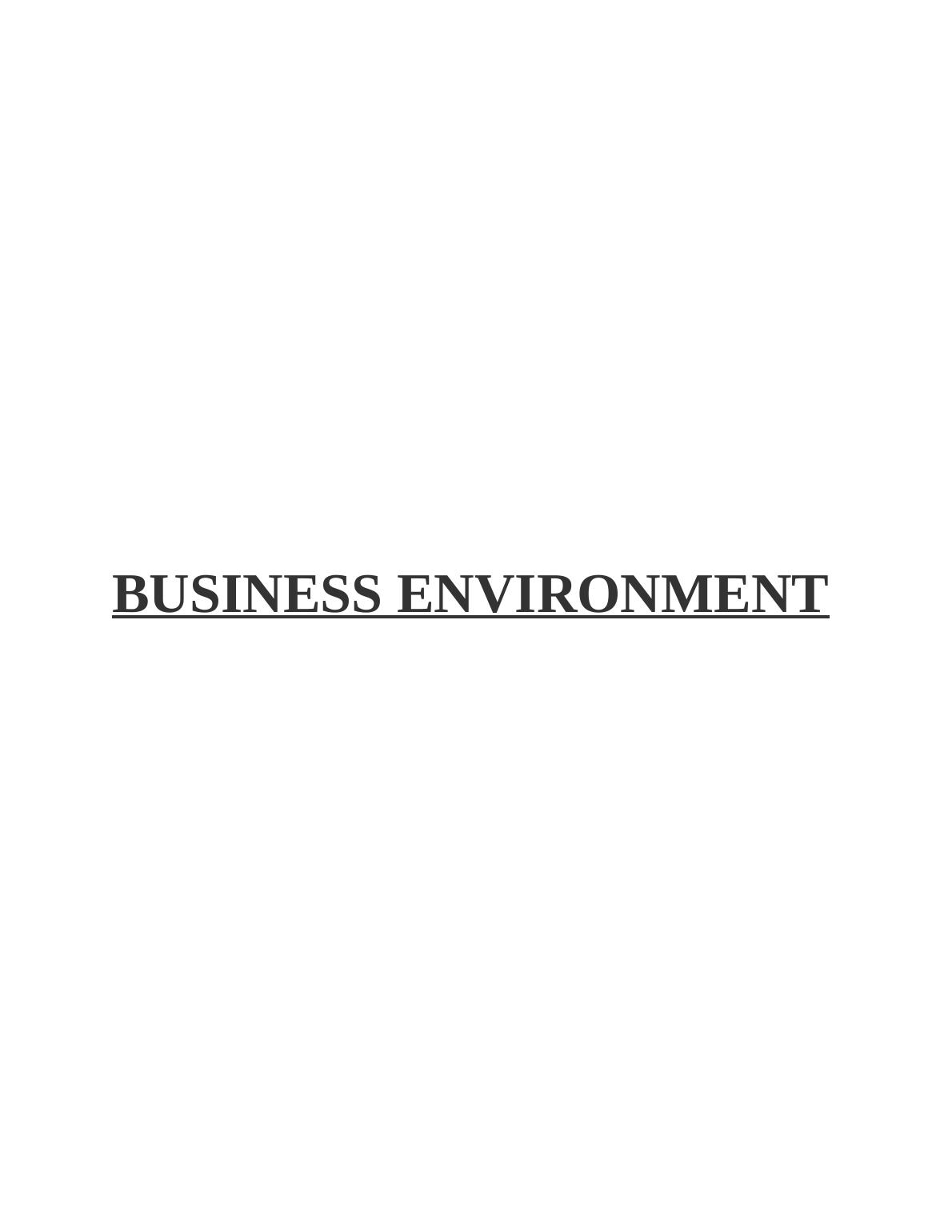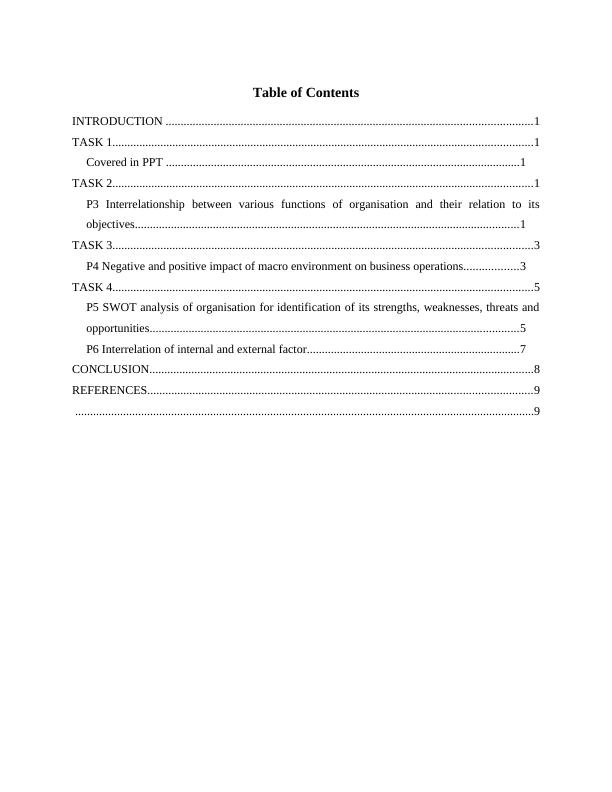Private Public and Voluntary sector
Explain different types and purposes of organisations; public, private and voluntary sectors and legal structures.
11 Pages3407 Words59 Views
Added on 2020-06-06
Private Public and Voluntary sector
Explain different types and purposes of organisations; public, private and voluntary sectors and legal structures.
Added on 2020-06-06
ShareRelated Documents
BUSINESS ENVIRONMENT

Table of ContentsINTRODUCTION ..........................................................................................................................1TASK 1............................................................................................................................................1Covered in PPT ......................................................................................................................1TASK 2............................................................................................................................................1P3 Interrelationship between various functions of organisation and their relation to itsobjectives................................................................................................................................1TASK 3............................................................................................................................................3P4 Negative and positive impact of macro environment on business operations..................3TASK 4............................................................................................................................................5P5 SWOT analysis of organisation for identification of its strengths, weaknesses, threats andopportunities...........................................................................................................................5P6 Interrelation of internal and external factor.......................................................................7CONCLUSION................................................................................................................................8REFERENCES................................................................................................................................9.........................................................................................................................................................9

INTRODUCTION Business environment is mainly classified into two aspects: Business and Environment.Both are considered as an important part of company's success and development (BusinessEnvironment, 2018). Business is defined as human activities like sales, extraction, purchase andproduction of services or products that are executed to earn more money. Further, Environmentis identified as an outlook of surroundings. So, with the assistance of both parts, businessenvironment is determined as a set of conditions: political, institutional, social, legal or economicthat is not controllable as well as impacts on organisation functions. It consists of two differentelements such as internal and external environment (Avramenko, 2012). Internal environmentcovers 5M's like machinery, money, man, material and management. On the other side, externalsituation consists of geo-physical, political, legal, government, demo-graphical and socialcultural factor. This project is based on three different types of organisations such as Private,Public and Voluntary that is: Nestle, NHS and Oxfam. This report also analysed various kindsand purpose of the mentioned three types of enterprises, scope and size of various types ofbusiness, relationship between organisational functions and its structure and objectives will bedetermined. Negative and positive effect of the macro-environmental force on businessoperations is also described in this study. Interrelation between internal and external factor isalso determined in this project. TASK 1Covered in PPT TASK 2P3 Interrelationship between various functions of organisation and their relation to its objectivesNestle is a fast food chain and multinational enterprise which gives their quality servicesand products to the customers worldwide. Main aim of the company is to earn maximum amountof money by fulfilling basic needs and wants of clients (Bovee, Thill and Raina, 2016). In thecompany, there are different departments are working like marketing, human resource, finance,operations and many other. All division have their own functions which support in achievementof common interest and objective. All department are interrelated with each other which help in1

completing all tasks and activities time to time. Interlink of various functions and its relation toorganisational structure and objectives are determined as below: Human resource department: Main function and activity of this division is designeffective workforce planning. It is beneficial for the enterprise to accomplish their predeterminedgoals and objectives in limited time period. Another role of HRM is identification ofremuneration, appointment of workers, appraisal of workforce performance and many other. Itassist in accomplishment of long term objectives of company in an effective manner. Finance department: It is a main department because without them an enterprise can notable to complete their activities effectively (Cavalcante, Kesting and Ulhøi, 2011). Main functionof this division is to prepare accurate budget which give guidelines to another areas likemarketing about success of their functions according to such quality. They gives better chancesabout use of advanced techniques to attain their targets. Marketing department: In Nestle, marketing department play vital role for innovatingnew goods and services in marketplace and to the customers. In order to complete such activity,marketing manager use different kind of promotional mix such as advertisement, publicity,promotion and many other channels. So all these are essential and beneficial for the enterprise toachieve long term success and growth effectively. Production department: In the organisation, main role of this department is tomanufacture various products as per the need and want of customer. Such departmentinterrelated with the marketing department. Without marketing Nestle can not introduce theirinnovative products and creative services to the clients. Organisational structure and objectives : It is classified into four parts which are determined asbelow: Function based: In this business entity is classified on the basis of different functions. Itmeans enterprise is segmented as a form of finance, marketing, human resource and productiondepartment (Hair, 2015). All these division are work with the achievement of long term goalsand objectives. Geography based: In this organisation structure is classified on the basis of countriesregions. It is an essential approach which assist in identification of the customers demand andwants. So it is also important for the company to easily fulfil basis needs of customers andaccomplish their predetermined goals in limited time period. 2

End of preview
Want to access all the pages? Upload your documents or become a member.
Related Documents
Introduction to the Business Environment | Studylg...
|12
|3716
|104
Assignment on Business Environment of Nestlelg...
|13
|3563
|47
Business Environment of Nestle : Assignmentlg...
|12
|3641
|45
Business Environment [pic] Introductionlg...
|13
|3815
|75
(BE)Business Environment Assignmentlg...
|13
|3647
|46
Business Environment of Nestle - Case Studylg...
|13
|2918
|100
